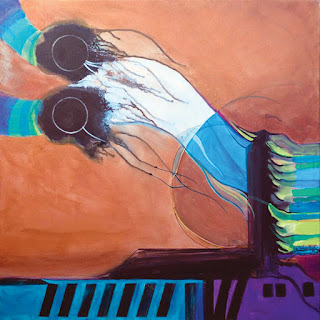Wednesday, August 10, 2016
V'Ahavtah....and you shall love....
One painted expression of the Sh'ma, was not going to be enough. When I took a closer look at the paragraphs following the opening lines, I realized that there was so much more to delve into, both visually and with words.
The first paragraph "and you shall love..." commands us to love G-d and instructs us in specific ways.
Thinking of this paragraph, I immediately chanted the first two trope marks that determine how the first word is sung. It seemed only fitting to start a painting the same way. As an aside, I am a Torah chanting geek. The rhythms, groupings and patterns delight my brain and challenge me in similar ways as do the design elements when I paint.
In black, (in right to left order), there is a right angle in the lower right corner and double dots in the upper left. Once the trope were laid in with bold brush strokes, a natural flow between the two formed. I was thinking of a tallit, the traditional prayer shawl, that helps us create a sacred space for prayer. The flowing lines allude to this garment and its fringe.
I have an affinity for copper. I even live in the copper state! I didn't understand, at the time, but all of the metallic colors in my paintings would come to symbolize the heavenly realm. These words of Torah originated in this realm. Silvers, coppers, golds and bronzes were going to show up in every painting in this Judaic series.
Complementary colors are opposites on the color wheel and create a natural balance for the viewer when used together. On a painter's color wheel, the opposite of copper (orange) is blue. Traditionally, blue is a color used for all things Jewish. It was a delightful realization to blend these two colors with their symbolic values together.
The pattern along the bottom is the diagram for tefillin, the phylacteries worn to bind's one's arm. One of the names of G-d is Shaddai and it is embodied in the wrappings, represented by the letter shin, the first letter of the name. Shaddai is also used on the parchment inside a mezuzah case, upon which these words are written and mounted on the doorposts of our homes, as commanded in this first paragraph.
I am far from finished with my need to express the Sh'ma and it's paragraphs, but it was time to respond to the call of other prayers that begged for attention...
Subscribe to:
Post Comments (Atom)

No comments:
Post a Comment